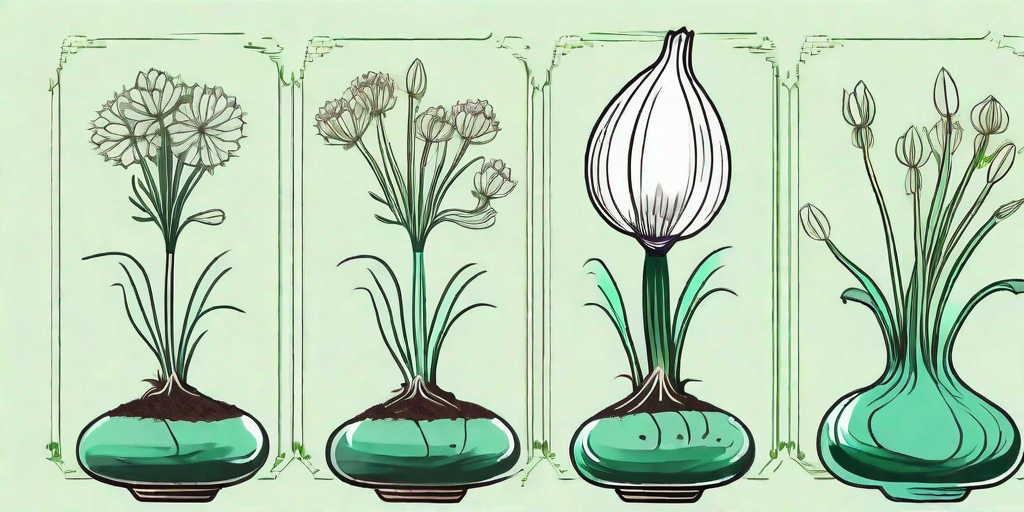
Onions, those tear-inducing kitchen staples, have a surprisingly fascinating life cycle. From their humble beginnings as a tiny seed to their grand finale as a flowering plant, onions take us on a botanical journey that's as layered as their bulbous hearts. So, grab your gardening gloves, and let's dig into the captivating world of onion plants flowering.
The Life Cycle of an Onion Plant
Before we delve into the details of onion plants flowering, let's take a quick tour of the onion's life cycle. Like all good stories, it starts with a seed. This tiny speck of potential is the beginning of our onion's journey, and it's where we'll begin our exploration.
As the seed germinates, it sends out roots and a shoot. This shoot will eventually become the onion's green, leafy top. The roots anchor the plant in the soil and absorb nutrients and water. As the plant grows, it begins to form a bulb. This bulb is what we typically think of when we think of onions, but it's just one part of the plant's life cycle.
Germination
Germination is the first stage in the life cycle of an onion. During this stage, the seed absorbs water and begins to swell. As it swells, the seed's outer layer cracks open, allowing the embryonic plant inside to emerge. This tiny plant, called a seedling, sends out roots and a shoot.
The roots anchor the seedling in the soil and begin to absorb nutrients and water. The shoot, or stem, grows upwards towards the light. As it grows, it produces leaves. These leaves are the first part of the plant to emerge above the soil, and they play a crucial role in photosynthesis, the process by which plants convert light energy into food.
Bulb Formation
As the onion plant grows, it begins to form a bulb. This bulb is essentially a swollen part of the stem, and it serves as a storage organ for the plant. The bulb is made up of layers, each one a leaf base that has swollen with nutrients.
The size of the bulb depends on a variety of factors, including the variety of onion, the growing conditions, and the length of the day. Some onions, like the Vidalia, are known for their large, sweet bulbs. Others, like the pearl onion, produce small, round bulbs.
The Flowering Process
Once the bulb has formed, the onion plant enters the next stage of its life cycle: flowering. This is the stage where the onion truly shines, producing a tall stalk topped with a cluster of small, white flowers. The flowering process is a complex one, involving a series of changes in the plant's growth and development.
The first sign of flowering is the appearance of a flower stalk. This stalk, also known as a scape, shoots up from the center of the bulb. As it grows, it produces a series of buds. These buds will eventually open to reveal the onion's flowers.
Flower Stalk Development
The flower stalk, or scape, is the first sign that an onion plant is about to flower. This tall, sturdy stalk shoots up from the center of the bulb, reaching heights of up to 6 feet in some varieties. As it grows, the scape produces a series of buds.
These buds are initially enclosed in a protective sheath. As they mature, the sheath splits open, revealing the buds inside. Each bud will eventually open to reveal a small, white flower.
Flower Formation
Once the buds have emerged, they begin to open. Each bud opens to reveal a small, white flower with six petals. These flowers are arranged in a cluster at the top of the scape, forming a spherical shape known as an umbel.
The flowers are not only beautiful, but they also play a crucial role in the onion's life cycle. They are the site of pollination, the process by which new onion seeds are produced. Once pollinated, each flower will produce a small, black seed. These seeds are the next generation of onions, ready to start their own journey from seed to flower.
FAQs
Why is my onion plant flowering?
Onion plants flower as part of their natural life cycle. However, if your onion plant is flowering before it has formed a large bulb, it may be due to stress. Factors such as temperature fluctuations, irregular watering, and poor soil conditions can cause an onion plant to bolt, or flower prematurely.
Can I still eat an onion that has flowered?
Yes, you can still eat an onion that has flowered. However, the bulb may be smaller and the flavor may be stronger than usual. It's also important to note that once an onion has flowered, it will not store well, so it's best to use it soon after harvesting.
How can I prevent my onion plants from flowering?
While you can't prevent an onion plant from flowering entirely, you can delay the process by providing optimal growing conditions. This includes regular watering, well-drained soil, and plenty of sunlight. Choosing onion varieties that are suited to your local climate can also help to prevent premature flowering.
Conclusion
From their humble beginnings as a tiny seed to their grand finale as a flowering plant, onions take us on a botanical journey that's as layered as their bulbous hearts. Whether you're a seasoned gardener or a curious cook, understanding the life cycle of an onion can add a new layer of appreciation to this versatile vegetable.
So next time you're chopping an onion, take a moment to consider the journey it's been on. From seed to scape, bulb to bloom, it's a journey that's as fascinating as it is flavorful. And who knows, you might even find yourself shedding a tear or two - and not just because of the onion's infamous eye-watering powers.











